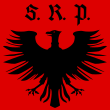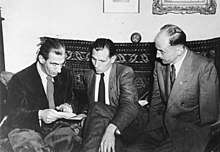Socialist Reich Party
The Socialist Reich Party (German: Sozialistische Reichspartei Deutschlands) was a West German political party founded in the aftermath of World War II in 1949 as an openly neo-Nazi-oriented split-off from the national conservative German Right Party (DKP-DRP). The party achieved some electoral success in northwestern Germany (Lower Saxony and Bremen).
Socialist Reich Party Sozialistische Reichspartei Deutschlands | |
|---|---|
 | |
| Abbreviation | SRP |
| Leader | Otto Ernst Remer Fritz Dorls Gerhard Krüger |
| Founded | 2 October 1949 |
| Banned | 23 October 1952 |
| Split from | Deutsche Rechtspartei |
| Merged into | Deutsche Reichspartei[1] |
| Youth wing | Reichsjugend |
| Paramilitary Wing | Reichsfront |
| Membership | c. 40,000[2] |
| Ideology | Neo-Nazism Lebensraum Third Position[3] |
| Political position | Far-right |
| Colors | Red and black |
| Party flag | |
 | |
| |
The SRP was the first party to be banned by the Federal Constitutional Court in 1952.
Origins
It was established on 2 October 1949 in Hameln by Otto Ernst Remer, a former Wehrmacht major general who had played a vital role in defeating the 20 July plot, Fritz Dorls, a former editor of the CDU newsletter in Lower Saxony, and Gerhard Krüger, leader of the German Student Union under the Third Reich, after they had been excluded from the DKP-DRP. The SRP saw itself as a legitimate heir of the Nazi Party; most party adherents were former NSDAP members. Its foundation was backed by former Luftwaffe Oberst Hans-Ulrich Rudel.

Party platform
The party claimed Chancellor Konrad Adenauer was a United States puppet and that Grand Admiral Karl Dönitz was the last legitimate President of the German Reich appointed by Adolf Hitler.[4] It denied the existence of the Holocaust, claimed that the United States built the gas ovens of the Dachau concentration camp after the War and that films of concentration camps were faked.[3] The SRP also advocated Europe, led by a reunited German Reich, as a "third force" against both capitalism and communism.[3] It demanded the re-annexation of the former eastern territories of Germany and a "solution of the Jewish question". According to Karl Dietrich Bracher, "SRP propaganda concentrated on a vague 'popular socialism' in which the old National Socialists rediscovered well-worn slogans, and also on a nationalism whose championship of Reich and war was but a thinly disguised continuation of the Lebensraum ideology".[5]
According to Martin A. Lee, the SRP never openly criticised the Soviet Union[6] because the Soviet Union funded the SRP as it held anti-American and pro-Soviet views. Lee alleges that the Communist Party of Germany, on the other hand, did not receive Soviet funds because it was purportedly viewed as "ineffectual".[7][8] Remer said that if the USSR ever did invade Germany, he would "show the Russians the way to the Rhine" and that SRP members would "post themselves as traffic policemen, spreading their arms so that the Russians can find their way through Germany as quickly as possible".[9][10]
Election results
Dorls had been elected as a DKP-DRP deputy to the Bundestag parliament in the 1949 election. The SRP gained a second seat in parliament, when MP Fritz Rössler (alias Dr. Franz Richter) joined the party in 1950. In May 1951 it won 16 seats in the Lower Saxony state assembly (Landtag) election, receiving 11.0% of the votes with strongholds in the Stade region (21.5%; Verden district: 27.7%).It included as a member the much decorated Luftwaffe ace Heinz Knoke. In October 1951 it gained 7.7% of the votes in Bremen and won 8 seats in the city's Bürgerschaft parliament.
Membership
The SRP had about ten thousand members. Affiliated associations were the Reichsfront paramilitary organisation and the Reichsjugend youth wing, which were banned by decision of the Federal Minister of the Interior on 4 May 1951. On the same day, the West German cabinet decided to file an application to the Federal Constitutional Court to find the SRP anti-constitutional and to impose a ban. In anticipation of this judgment, the party dissolved itself on 12 September, but this decision was not accepted by the Federal Constitutional Court. Before the ban, Remer had compared the situation of the SRP with that of the early Christians and declared that if the party was banned, he and his party comrades should descend into the catacombs.[11] On 23 October 1952 the court according to Article 21 Paragraph 2 of the Basic Law adjudicated the party unconstitutional and dissolved, prohibited the founding of any successor organisations, withdraw all Bundestag and Landtag mandates and seized the party's assets (BVerfGE 2, 1).
See also
Notes
- Siehe Bericht des bayrischen Verfassungsschutzes, Rechtsextremismus: "Archived copy". Archived from the original on 2008-05-16. Retrieved 2009-09-16.CS1 maint: archived copy as title (link)
- Dominik Geppert: The Adenauer era . 3. Edition. WBG, Darmstadt 2012, ISBN 978-3-534-24900-8 , p. 77 .
- Lee, p. 50.
- Martin A. Lee, The Beast Reawakens (Warner Books, 1998), p. 50.
- Karl Dietrich Bracher, The German Dictatorship. The Origins, Structure, and Consequences of National Socialism (Penguin, 1991), p. 581.
- Lee, p. 58.
- Lee, pp. 74-75.
- "Encyclopedia of modern worldwide extremists and extremist groups", Stephen E. Atkins. Greenwood Publishing Group, 2004. ISBN 0-313-32485-9, ISBN 978-0-313-32485-7. pp. 273-274
- Lee, p. 65.
- T. H. Tetens, The New Germany and the Old Nazis (London: Secker & Warburg, 1962), p. 78.
- Lee: The Beast Reawakens, pp. 82–83.
External links
- Germany's New Nazis 1951 pamphlet about the SRP and other neo-nazi groups by the Anglo-Jewish Association